technical data SKODA OCTAVIA 2007 1.G / (1U) Owner's Manual
[x] Cancel search | Manufacturer: SKODA, Model Year: 2007, Model line: OCTAVIA, Model: SKODA OCTAVIA 2007 1.G / (1U)Pages: 288, PDF Size: 15.19 MB
Page 206 of 288

Taking care of your vehicle and cleaning the vehicle205
Using the systemSafetyDriving TipsGeneral MaintenanceBreakdown assistanceTechnical Data
Removing stains
– Remove fresh stains which are water-based (e.g. coffee, tea, juices,
blood etc.) with an absorbent cloth or household paper or use the
cleaner from the care set for a stain which has already dried in.
– Remove fresh stains on a fat base (e.g. butter, mayonnaise, chocolate
etc.) with an absorbent cloth or household cleaning paper or with the
cleaner from the care set if the stain has not yet penetrated into the
surface.
– Use a grease dissolver for grease stains which have dried in .
–Eliminate special stains (e.g. ball-point pens, felt pen, nail varnish,
dispersion paint, shoe cream etc.) with a special stain remover suit-
able for leather.
Leather care
– Treat the leather every six months with the leather care product avail- able from Škoda Service Partners.
– Apply only a small amount of the care product.
– Dry the leather off with a soft cloth
It is best to consult your Škoda Service Partner if you have any questions regarding
cleaning and care of the leather interior.
Caution
•You must on no account treat the leathe r with solvents (e.g. gasoline, turpen-
tine), floor wax, shoe cream or such like.
•Avoid leaving your vehicle for lengthy pe riods in bright sunlight in order to
avoid bleaching the leather. If you leave your vehicle parked in the open for lengthy
periods, protect the leather from the direct rays of the sun by covering it over.
•Sharp-edged objects on items of clothing such as zip fasteners, rivets, sharp-
edged belts may leave permanent scratche s or signs of rubbing on the surface.
Note
•Use a care cream with light blocker and impregnation effect regularly and each
time after cleaning the leather. The cream no urishes the leather, allows it to breathe
and keeps it supple and also provides moisture. It also creates surface protection.
•Clean the leather every 2 to 3 months, remove fresh soiling each time this
occurs.
•Remove fresh stains such as those from ball-point pens, ink, lipstick, shoe
cream etc., as quickly as possible.
•Care also for the leather dye. Refreshen areas which have lost their colour with
a special coloured leather cream as required.
Seat belts
– Keep the seat belts clean!
– Wash seat belts which have become soiled using a mild soapy solu-
tion.
– Inspect the seat belts regularly to ensure they are in good condition.
Belt webbing which has become severely so iled may prevent the inertia reel from
reeling up the belt properly.
WARNING
•The seat belts must not be removed for cleaning.
•Never clean the seat belts chemically as dry cleaning may destroy the
fabric. The seat belts must also not be allowed to come into contact with
corrosive liquids (such as acids etc.).
•Seat belts which have damage to the webbing, the connections, the
inertia reel or the lock should be replaced by a Škoda Service Partner.
•Inertia reel belts must be completely dried before being reeled up.
NKO A5 20 MR08.book Page 205 Wednesday, April 11, 2007 2:54 PM
Page 207 of 288

Fuel
206
Fuel
Petrol
Grades of petrol
There are various grades of petrol. Please read ⇒page 255, “Technical Data” in
order to know which grade of petrol your vehicle requires. You will also find the
same information affixed to the inside of the fuel filler flap of your vehicle
⇒ page 207, fig. 193 .
A distinction is made betwee n unleaded and leaded petrol . All Škoda vehicles with
petrol engines are equipped with a cataly tic converter and must therefore be only
driven with unleaded petrol . Unleaded petrol complies with the standard
DINEN228 .
The individual grades of petr ol are distinguished by their octane number (RON).
Please adopt the following procedure if th e grade of petrol which you normally use
is not be available in exceptional circumstances:
•Engines which need unleaded premium petrol 95 RON can also be run on
unleaded regular petrol 91 RON. This does, however, result in a slight loss in
performance.
•Engines which need unleaded premium plus petrol 98 RON can also be run
on unleaded regular petrol 95 RON. This do es, however, result in a slight loss in
performance. You can in exceptional circumstances also use unleaded regular
petrol of 91 RON in the event that neither unleaded premium petrol of 98 RON nor
95 RON is available. Refuel as soon as possible with unleaded premium plus of 98
RON or unleaded premium petrol of 95 RON.
If, in an emergency, the only fuel availa ble is one which has a lower octane number
than that required by the engine then only drive at medium engine speeds and
lower engine loadings.
You can make unlimited use of fuel which has a higher octane number than that
required by the engine. There will, however, be no advantages gained by this in
terms of engine performa nce and fuel consumption! The handling, performance and life of your
engine are determined to a significant
extent by the quality of the fuel. Do not use any petrol additives. Use a fuel
complying with the standard.
You can find further information on refuelling ⇒page 207, “Refuelling”.
Caution
•Filling the tank even only once with le aded petrol will result in the catalytic
converter being destroyed.
•Operating the engine with petrol of a low octane number can result in engine
damage at high revolutions or severe engine loading.
Diesel
Diesel fuel
Your vehicle can be operated with diesel fuel, which complies with the standard
DIN EN 590.
Fuel additives
You must not use fuel additives, so-ca lled “flow improvers” (petrol and similar
products) in diesel fuel.
If the quality of the diesel fuel is p oor, it is then necessary to drain the fuel filter
more often than stated in the Service schedule.
You can find information on refuelling ⇒page 207, “Refuelling”.
Caution
•Use a fuel which complies with the standard DINEN590. Filling the tank even
only once, which does not comply with th e standard, can result in damage to the
fuel system.
•Water which has collected in the fuel filter can result in engine problems.
NKO A5 20 MR08.book Page 206 Wednesday, April 11, 2007 2:54 PM
Page 208 of 288

Fuel207
Using the systemSafetyDriving TipsGeneral MaintenanceBreakdown assistanceTechnical Data
•Your vehicle is not adapted for use of biofuel (RME), therefore this fuel must not
be refuelled and driven. Using this fuel (RME) can lead to damage to the engine or
the fuel system.
Operation in winter
Winter-grade diesel fuel
A different grade of diesel fuel is available at filling stations in winter than during the
summer. Using “summer-grade diesel fuel” at temperatures below 0°C can result in
operational problems because the diesel be comes viscous as a result of paraffin
separation.
It is therefore the case that DIN EN 590 prescribes diesel fuel class for certain
periods of the year which can also be pu rchased at the corresponding time during
the year. “Winter-grade diesel fuel” will still operate properly even at a temperature
of -20°C.
It is often the case in countries with diff erent climatic conditions that diesel fuels
available have a different temperature characteristic. Škoda Service Partners and
filling stations in the count ry concerned will be able to provide you with informa-
tion regarding the diesel fuels available.
Prewarming fuel
The vehicle is fitted with a fuel filter prewarming system. This secures operation of
a vehicle using diesel fuel down to an environmental temperature of -25°C.
Caution
It is not permitted to add the various fuel additives on the market, including petrol,
to diesel fuel in order to improve its flow properties.
Refuelling
The filler flap is automatically unl ocked or locked* with the central
locking.
Opening the fuel filler cap
– Press onto the left side of the fuel filler flap ⇒fig. 192 .
– The fuel filler cap on the fuel filler tube must be unlocked to the left using the vehicle key (only valid for vehicles which do not have auto-
matic unlocking of the fuel filler flap).
Fig. 192 Right rear side
of the vehicle: Fuel filler
flap
Fig. 193 Filler flap with
cap unscrewed
NKO A5 20 MR08.book Page 207 Wednesday, April 11, 2007 2:54 PM
Page 210 of 288

Inspecting and Replenishing209
Using the systemSafetyDriving TipsGeneral MaintenanceBreakdown assistanceTechnical Data
Inspecting and Replenishing
Engine compartment
Bonnet remote release
Bonnet remote release
– Pull the unlocking lever below the dash panel on the driver's side
⇒ fig. 194 .
The bonnet jumps out of its lock as a result of the spring force. A handle appears at
the same time in the radiator grille.
Opening and closing the bonnet.
Opening the bonnet
– Unlock the bonnet ⇒fig. 194 .
– Ensure that the arms of the windscreen wipers are correctly in place against the windscreen before opening the bonnet otherwise
damage could occur to the paintwork.
– Pulling on the handle ⇒fig. 195 will lock the bonnet fully.
Fig. 194 Bonnet release
lever
Fig. 195 Radiator grille:
handle
Fig. 196 Securing the
bonnet with the bonnet
support
NKO A5 20 MR08.book Page 209 Wednesday, April 11, 2007 2:54 PM
Page 212 of 288
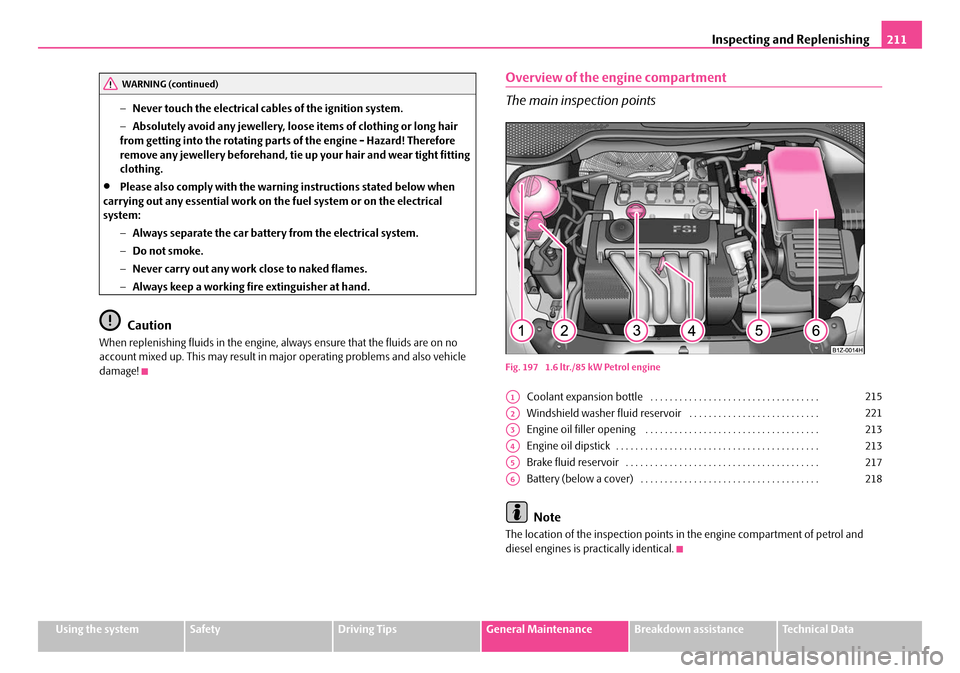
Inspecting and Replenishing211
Using the systemSafetyDriving TipsGeneral MaintenanceBreakdown assistanceTechnical Data
−
Never touch the electrical cabl es of the ignition system.
− Absolutely avoid any jewellery, loose items of clothing or long hair
from getting into the rotating parts of the engine - Hazard! Therefore
remove any jewellery beforehand, tie up your hair and wear tight fitting
clothing.
•Please also comply with the warnin g instructions stated below when
carrying out any essential work on the fuel system or on the electrical
system:
−Always separate the car batter y from the electrical system.
− Do not smoke.
− Never carry out any work close to naked flames.
− Always keep a working fire extinguisher at hand.
Caution
When replenishing fluids in the engine, al ways ensure that the fluids are on no
account mixed up. This may result in ma jor operating problems and also vehicle
damage!
Overview of the engine compartment
The main inspection points
Fig. 197 1.6 ltr./85 kW Petrol engine
Coolant expansion bottle . . . . . . . . . . . . . . . . . . . . . . . . . . . . . . . . . . .
Windshield washer fluid reservoir . . . . . . . . . . . . . . . . . . . . . . . . . . .
Engine oil filler opening . . . . . . . . . . . . . . . . . . . . . . . . . . . . . . . . . . . .
Engine oil dipstick . . . . . . . . . . . . . . . . . . . . . . . . . . . . . . . . . . . . . . . . . .
Brake fluid reservoir . . . . . . . . . . . . . . . . . . . . . . . . . . . . . . . . . . . . . . . .
Battery (below a cover) . . . . . . . . . . . . . . . . . . . . . . . . . . . . . . . . . . . . .
Note
The location of the inspection points in the engine compartment of petrol and
diesel engines is practically identical.
WARNING (continued)
A1215
A2221
A3213
A4213
A5217
A6218
NKO A5 20 MR08.book Page 211 Wednesday, April 11, 2007 2:54 PM
Page 214 of 288
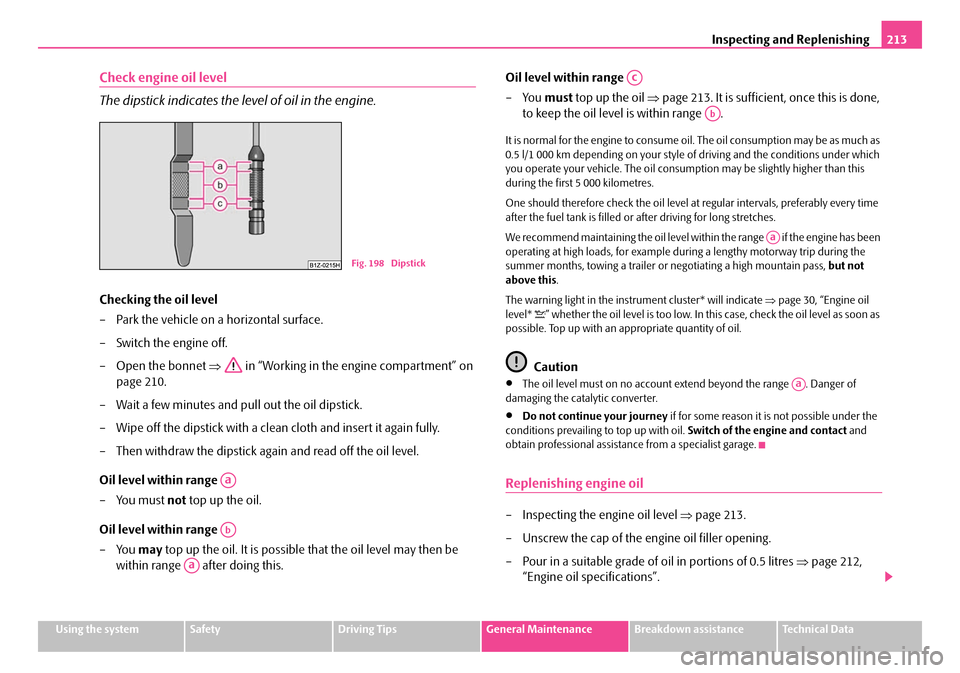
Inspecting and Replenishing213
Using the systemSafetyDriving TipsGeneral MaintenanceBreakdown assistanceTechnical Data
Check engine oil level
The dipstick indicates the level of oil in the engine.
Checking the oil level
– Park the vehicle on a horizontal surface.
– Switch the engine off.
– Open the bonnet ⇒ in “Working in the engine compartment” on
page 210.
– Wait a few minutes and pull out the oil dipstick.
– Wipe off the dipstick with a clea n cloth and insert it again fully.
– Then withdraw the dipstick ag ain and read off the oil level.
Oil level within range
– You must not top up the oil.
Oil level within range
– You may top up the oil. It is possible that the oil level may then be
within range after doing this. Oil level within range
–You
must top up the oil ⇒page 213. It is sufficient, once this is done,
to keep the oil level is within range .
It is normal for the engine to consume oil. The oil consumption may be as much as
0.5 l/1 000 km depending on your style of driving and the conditions under which
you operate your vehicle. The oil consumpt ion may be slightly higher than this
during the first 5 000 kilometres.
One should therefore check the oil level at regular intervals, preferably every time
after the fuel tank is filled or after driving for long stretches.
We recommend maintaining the oil level within the range if the engine has been
operating at high loads, for example during a lengthy motorway trip during the
summer months, towing a trailer or negotiating a high mountain pass, but not
above this .
The warning light in the instrument cluster* will indicate ⇒page 30, “Engine oil
level* ” whether the oil level is too low. In this case, check the oil level as soon as
possible. Top up with an a ppropriate quantity of oil.
Caution
•The oil level must on no account ex tend beyond the range . Danger of
damaging the catalytic converter.
•Do not continue your journey if for some reason it is not possible under the
conditions prev ailing to top up with oil. Switch of the engine and contact and
obtain professional assistance from a specialist garage.
Replenishing engine oil
– Inspecting the engine oil level ⇒page 213.
– Unscrew the cap of the engine oil filler opening.
– Pour in a suitable grade of oil in portions of 0.5 litres ⇒page 212,
“Engine oil specifications”.
Fig. 198 Dipstick
Aa
Ab
Aa
Ac
Ab
Aa
Aa
NKO A5 20 MR08.book Page 213 Wednesday, April 11, 2007 2:54 PM
Page 216 of 288
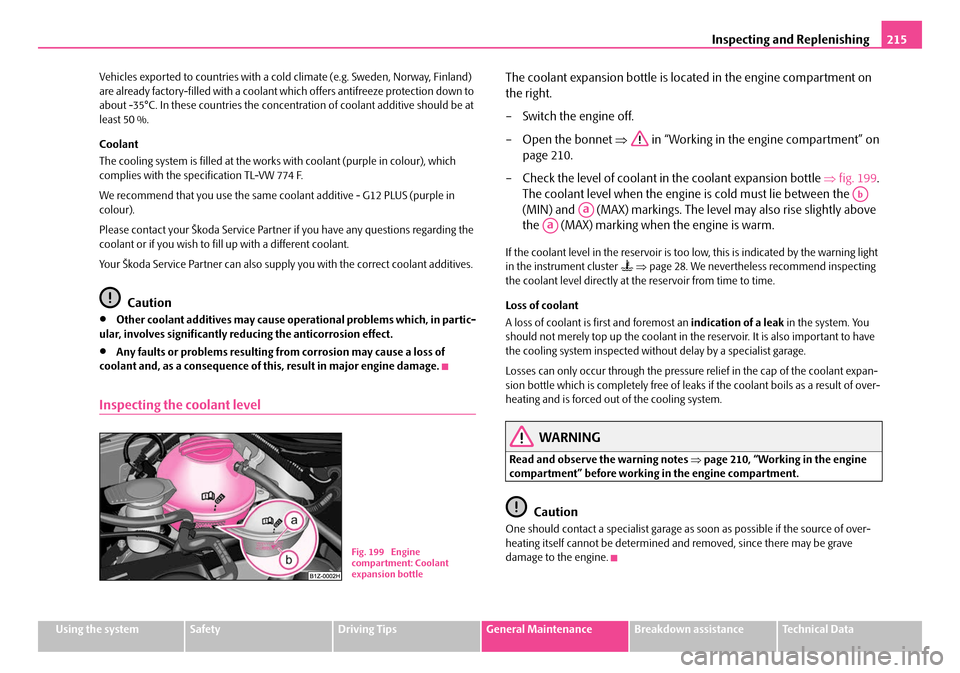
Inspecting and Replenishing215
Using the systemSafetyDriving TipsGeneral MaintenanceBreakdown assistanceTechnical Data
Vehicles exported to countries with a co
ld climate (e.g. Sweden, Norway, Finland)
are already factory-filled with a coolant wh ich offers antifreeze protection down to
about -35°C. In these countries the concentr ation of coolant additive should be at
least 50 %.
Coolant
The cooling system is filled at the works with coolant (purple in colour), which
complies with the specification TL-VW 774 F.
We recommend that you use the same coolant additive - G12 PLUS (purple in
colour).
Please contact your Škoda Service Partner if you have any questions regarding the
coolant or if you wish to fill up with a different coolant.
Your Škoda Service Partner can also suppl y you with the correct coolant additives.
Caution
•Other coolant additives may cause operational problems which, in partic-
ular, involves significantly redu cing the anticorrosion effect.
•Any faults or problems resulting from corrosion may cause a loss of
coolant and, as a consequence of th is, result in major engine damage.
Inspecting the coolant level
The coolant expansion bottle is located in the engine compartment on
the right.
– Switch the engine off.
– Open the bonnet ⇒ in “Working in the engine compartment” on
page 210.
– Check the level of coolant in the coolant expansion bottle ⇒fig. 199 .
The coolant level when the engine is cold must lie between the
(MIN) and (MAX) markings. The level may also rise slightly above
the (MAX) marking when the engine is warm.
If the coolant level in the reservoir is too low, this is indicated by the warning light
in the instrument cluster ⇒ page 28. We neve rtheless recommend inspecting
the coolant level directly at the reservoir from time to time.
Loss of coolant
A loss of coolant is first and foremost an indication of a leak in the system. You
should not merely top up the coolant in the reservoir. It is also important to have
the cooling system inspected without delay by a specialist garage.
Losses can only occur through the pressure relief in the cap of the coolant expan-
sion bottle which is completely free of leak s if the coolant boils as a result of over-
heating and is forced out of the cooling system.
WARNING
Read and observe the warning notes ⇒page 210, “Working in the engine
compartment” before working in the engine compartment.
Caution
One should contact a specialist garage as soon as possible if the source of over-
heating itself cannot be determined and removed, since there may be grave
damage to the engine.
Fig. 199 Engine
compartment: Coolant
expansion bottle
Ab
Aa
Aa
NKO A5 20 MR08.book Page 215 Wednesday, April 11, 2007 2:54 PM
Page 218 of 288

Inspecting and Replenishing217
Using the systemSafetyDriving TipsGeneral MaintenanceBreakdown assistanceTechnical Data
Brake fluid
Inspecting the brake fluid level
The brake fluid reservoir is located on the left of the engine compartment.
The brake fluid reservoir on right-hand steering models is positioned on
the other side of the engine compartment.
– Switch the engine off.
– Open the bonnet ⇒ in “Working in the engine compartment” on
page 210.
– Inspect the brake fluid level in the reservoir ⇒fig. 200 . The level must
be between the “MIN” and “MAX” markings.
A slight drop in the fluid level results when driving due to normal wear-and-tear
and automatic adjustment of the br ake pads, and is perfectly normal.
There may be an indication of a leak in the brake system, however, if the fluid level
drops significantly within a short time or if it drops below the “MIN” marking. A situ-
ation where the brake fluid level is too low is indicated by the warning light
lighting up in the instrument cluster ⇒page 32. In this case stop the car immedi-
ately and do not drive any further! Co ntact a Škoda Dealer to obtain profes-
sional assistance.
WARNING
•Read and observe the warning notes ⇒page 210, “Working in the engine
compartment” before working in the engine compartment.
•If the fluid level has dropped below the MIN marking, do not drive any
further - risk of accident! Contact a Škoda dealer to obtain professional
assistance.
Replacing brake fluid
Brake fluid absorbs moisture. This causes the fluid to absorb moisture from the
surrounding air over a period of time. Excessive water in the brake fluid may be the
cause of corrosion in the brake system. Th e water content also lowers the boiling
point of the brake fluid. This is why brake fluid must be replaced every two
years.
One may only use new genuine brake fluid from Škoda Auto a.s. The specification
for the brake fluid is “FMVSS 116 DOT 4”.
We recommend that you have the brake fluid replaced by a Škoda Service Partner
as part of an Inspection Service.
WARNING
•Using old brake fluid can result in seve re stress on the brakes because of
the formation of vapour bubbles in th e brake system. This greatly impairs
the braking efficiency and thus al so the safety of your vehicle.
•Brake fluid is toxic! It must therefor e be kept safely in closed original
containers and well away from children and unauthorized persons.
Caution
Brake fluid damages the paintwork of the vehicle.
Fig. 200 Engine
compartment: Brake
fluid reservoir
NKO A5 20 MR08.book Page 217 Wednesday, April 11, 2007 2:54 PM
Page 220 of 288
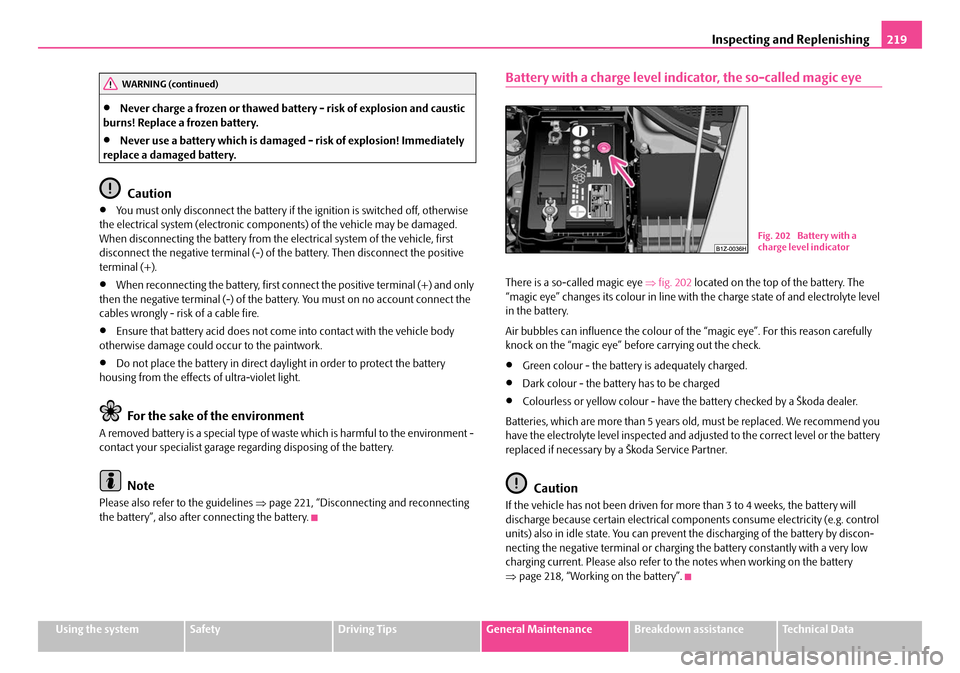
Inspecting and Replenishing219
Using the systemSafetyDriving TipsGeneral MaintenanceBreakdown assistanceTechnical Data
•Never charge a frozen or thawed battery - risk of explosion and caustic
burns! Replace a frozen battery.
•Never use a battery which is damaged - risk of explosion! Immediately
replace a damaged battery.
Caution
•You must only disconnect the battery if the ignition is switched off, otherwise
the electrical system (electronic compon ents) of the vehicle may be damaged.
When disconnecting the battery from the electrical system of the vehicle, first
disconnect the negative terminal (-) of the battery. Then disconnect the positive
terminal (+).
•When reconnecting the battery, first conne ct the positive terminal (+) and only
then the negative terminal (-) of the ba ttery. You must on no account connect the
cables wrongly - risk of a cable fire.
•Ensure that battery acid does not come into contact with the vehicle body
otherwise damage could occur to the paintwork.
•Do not place the battery in direct dayl ight in order to protect the battery
housing from the effects of ultra-violet light.
For the sake of the environment
A removed battery is a special type of waste which is harmful to the environment -
contact your specialist garage regarding disposing of the battery.
Note
Please also refer to the guidelines ⇒page 221, “Disconnecting and reconnecting
the battery”, also after connecting the battery.
Battery with a charge level indicator, the so-called magic eye
There is a so-called magic eye ⇒fig. 202 located on the top of the battery. The
“magic eye” changes its colour in line with the charge state of and electrolyte level
in the battery.
Air bubbles can influence the colour of th e “magic eye”. For this reason carefully
knock on the “magic eye” before carrying out the check.
•Green colour - the battery is adequately charged.
•Dark colour - the battery has to be charged
•Colourless or yellow colour - have th e battery checked by a Škoda dealer.
Batteries, which are more than 5 years old, must be replaced. We recommend you
have the electrolyte level inspected and adju sted to the correct level or the battery
replaced if necessary by a Škoda Service Partner.
Caution
If the vehicle has not been driven for more than 3 to 4 weeks, the battery will
discharge because certain electrical components consume electricity (e.g. control
units) also in idle state. You can prevent the discharging of the battery by discon-
necting the negative terminal or charging the battery constantly with a very low
charging current. Please also refer to the notes when working on the battery
⇒ page 218, “Working on the battery”.
WARNING (continued)
Fig. 202 Battery with a
charge level indicator
NKO A5 20 MR08.book Page 219 Wednesday, April 11, 2007 2:54 PM
Page 222 of 288
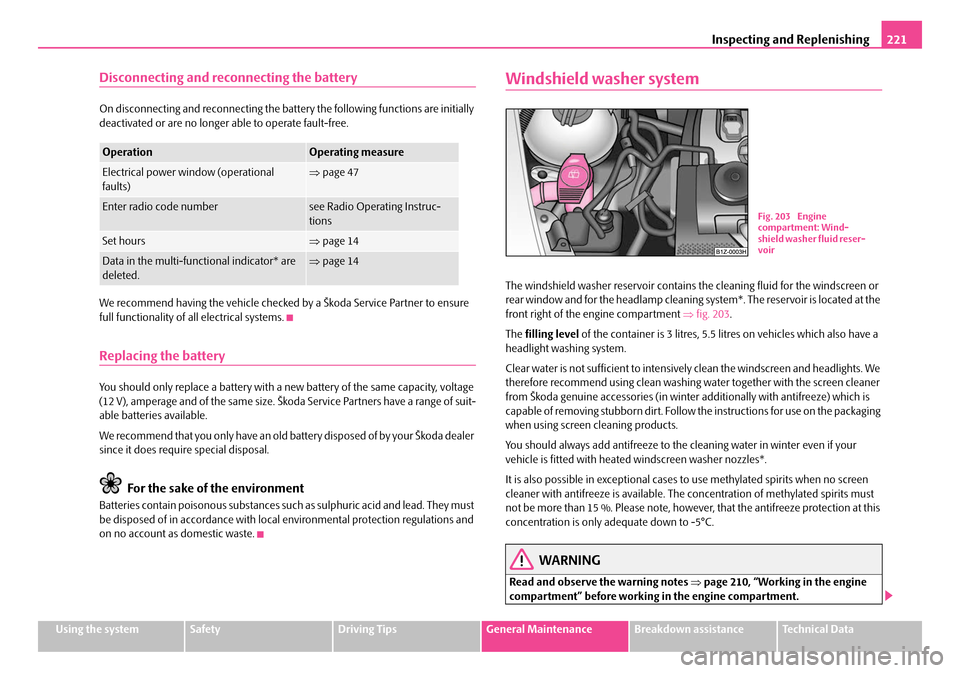
Inspecting and Replenishing221
Using the systemSafetyDriving TipsGeneral MaintenanceBreakdown assistanceTechnical Data
Disconnecting and reconnecting the battery
On disconnecting and reconnecting the batte ry the following functions are initially
deactivated or are no longer able to operate fault-free.
We recommend having the ve hicle checked by a Škoda Service Partner to ensure
full functionality of all electrical systems.
Replacing the battery
You should only replace a battery with a new battery of the same capacity, voltage
(12 V), amperage and of the same size. Škoda Service Partners have a range of suit-
able batteries available.
We recommend that you only have an old ba ttery disposed of by your Škoda dealer
since it does require special disposal.
For the sake of the environment
Batteries contain poisonous substances such as sulphuric acid and lead. They must
be disposed of in accordance with loca l environmental protection regulations and
on no account as domestic waste.
Windshield washer system
The windshield washer reservoir contains the cleaning fluid for the windscreen or
rear window and for the headlamp cleaning system*. The reservoir is located at the
front right of the engine compartment ⇒fig. 203 .
The filling level of the container is 3 litres, 5.5 li tres on vehicles which also have a
headlight washing system.
Clear water is not sufficient to intensivel y clean the windscreen and headlights. We
therefore recommend using clean washing water together with the screen cleaner
from Škoda genuine accessories (in winter additionally with antifreeze) which is
capable of removing stubborn dirt. Follow the instructions for use on the packaging
when using screen cleaning products.
You should always add antifreeze to the cleaning water in winter even if your
vehicle is fitted with heated windscreen washer nozzles*.
It is also possible in exceptional cases to use methylated spirits when no screen
cleaner with antifreeze is available. The concentration of methylated spirits must
not be more than 15 %. Please note, however, that the antifreeze protection at this
concentration is only adequate down to -5°C.
WARNING
Read and observe the warning notes ⇒page 210, “Working in the engine
compartment” before working in the engine compartment.
OperationOperating measure
Electrical power window (operational
faults)⇒ page 47
Enter radio code numbersee Radio Operating Instruc-
tions
Set hours⇒page 14
Data in the multi-functional indicator* are
deleted.⇒page 14
Fig. 203 Engine
compartment: Wind-
shield washer fluid reser-
voir
NKO A5 20 MR08.book Page 221 Wednesday, April 11, 2007 2:54 PM